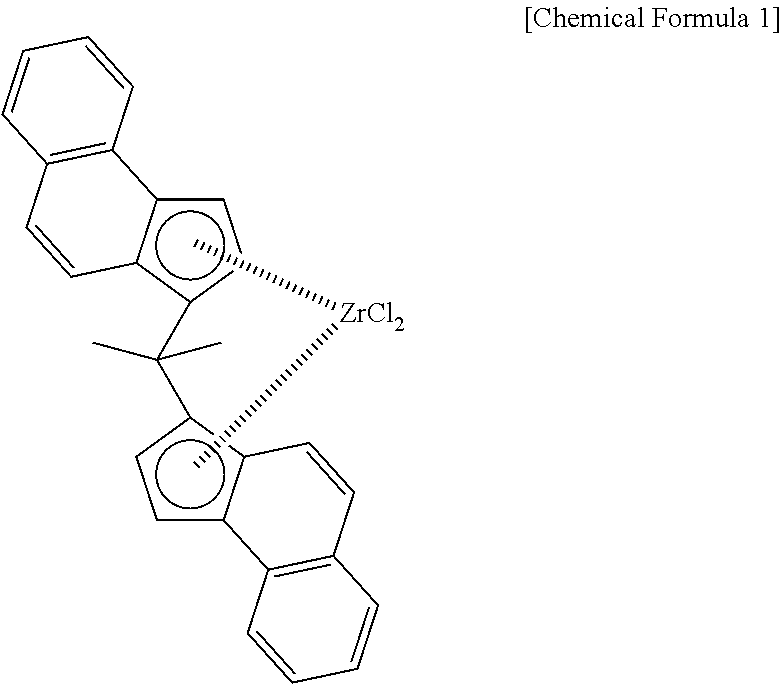Thermoplastic elastomer resin composition
a technology of elastomer and resin, which is applied in the field of thermoplastic elastomer resin composition, can solve the problems of recycling and environmental hormones, drawbacks of having inferior scratch resistance of the surface due to fabrics, fingernails or the like, and defects in appearance, and achieves good heat fusion ability, oil resistance and scratch resistance, and excellent tensile breaking strength
- Summary
- Abstract
- Description
- Claims
- Application Information
AI Technical Summary
Benefits of technology
Problems solved by technology
Method used
Image
Examples
synthesis example 1
Synthesis of Cross-Copolymer (I)
[0078]Polymerization was performed using an autoclave with a capacity of 50 L, equipped with a stirrer and a heating / cooling jacket.
[0079]23.1 kg of cyclohexane, 2.9 kg of styrene and divinylbenzene manufactured by Nippon Steel Chemical (meta- and para-mixture, 73 mmol as divinylbenzene) were loaded and stirred at 220 rpm with an internal temperature of 60° C. Next, 50 mmol of triisobutyl aluminum and 65 mmol of methyl aluminoxane (produced by Toso FineChem, MMAO-3A / toluene solution) on Al-basis were added, and the gas in the system was immediately substituted with ethylene. After substitution, the internal temperature was raised to 90° C. and ethylene was fed to make the pressure 0.39 MPaG. Thereafter, 50 ml of a toluene solution into which were dissolved 110 μmol of rac-dimethylmethylene bis(4,5-benzo-1-indenyl)zirconium dichloride and 1 mmol of triisobutyl aluminum was added to the autoclave. Polymerization immediately began, and the internal tempe...
synthesis example 2
Synthesis of Cross-Copolymer (II)
[0081]Polymerization was performed using an autoclave with a capacity of 50 L, equipped with a stirrer and a heating / cooling jacket.
[0082]20.8 kg of cyclohexane, 3.6 kg of styrene and divinylbenzene manufactured by Nippon Steel Chemical (meta- and para-mixture, 58 mmol as divinylbenzene) were loaded and stirred at 220 rpm with an internal temperature of 60° C. Next, 50 mmol of triisobutyl aluminum and 75 mmol of methyl aluminoxane (produced by Toso FineChem, MMAO-3A / toluene solution) on Al-basis were added, and the gas in the system was immediately substituted with ethylene. After substitution, the internal temperature was raised to 90° C. and ethylene was fed to make the pressure 0.45 MPaG. Thereafter, 50 ml of a toluene solution into which were dissolved 110 μmol of rac-dimethylmethylene bis(4,5-benzo-1-indenyl)zirconium dichloride and 1 mmol of triisobutyl aluminum was added to the autoclave. Polymerization immediately began, and the internal temp...
synthesis example 3
Synthesis of Cross-Copolymer (III)
[0084]Polymerization was performed using an autoclave with a capacity of 50 L, equipped with a stirrer and a heating / cooling jacket.
[0085]17.4 kg of cyclohexane, 5.3 kg of styrene and divinylbenzene manufactured by Nippon Steel Chemical (meta- and para-mixture, 102 mmol as divinylbenzene) were loaded and stirred at 220 rpm with an internal temperature of 60° C. Next, 50 mmol of triisobutyl aluminum and 75 mmol of methyl aluminoxane (produced by Toso FineChem, MMAO-3A / toluene solution) on Al-basis were added, and the gas in the system was immediately substituted with ethylene. After substitution, the internal temperature was raised to 90° C. and ethylene was fed to make the pressure 0.45 MPaG. Thereafter, 50 ml of a toluene solution into which were dissolved 100 μmol of rac-dimethylmethylene bis(4,5-benzo-1-indenyl)zirconium dichloride and 1 mmol of triisobutyl aluminum was added to the autoclave. Polymerization immediately began, and the internal te...
PUM
| Property | Measurement | Unit |
|---|---|---|
| mol % | aaaaa | aaaaa |
| mol % | aaaaa | aaaaa |
| mol % | aaaaa | aaaaa |
Abstract
Description
Claims
Application Information
 Login to View More
Login to View More - R&D
- Intellectual Property
- Life Sciences
- Materials
- Tech Scout
- Unparalleled Data Quality
- Higher Quality Content
- 60% Fewer Hallucinations
Browse by: Latest US Patents, China's latest patents, Technical Efficacy Thesaurus, Application Domain, Technology Topic, Popular Technical Reports.
© 2025 PatSnap. All rights reserved.Legal|Privacy policy|Modern Slavery Act Transparency Statement|Sitemap|About US| Contact US: help@patsnap.com

